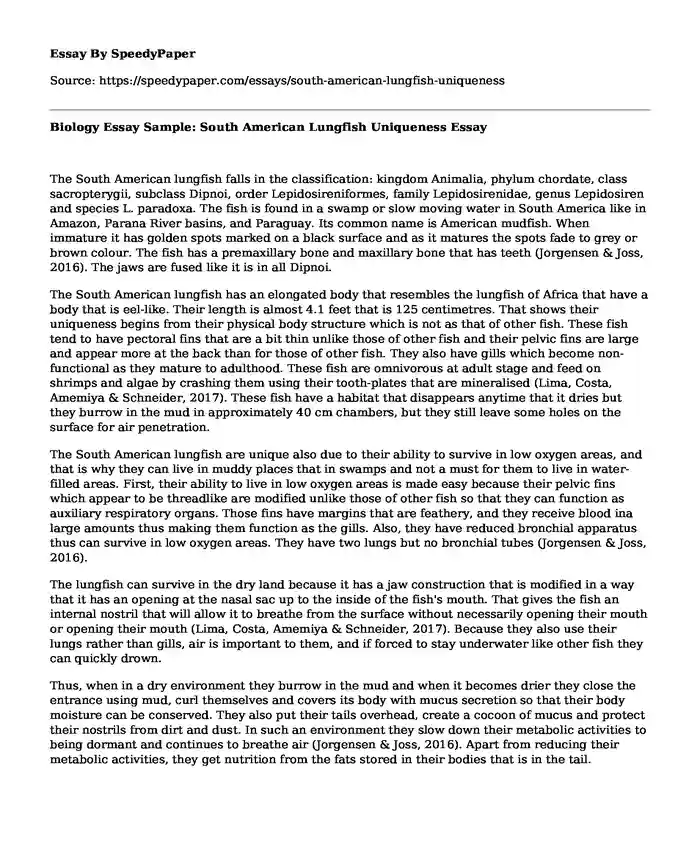The South American lungfish falls in the classification: kingdom Animalia, phylum chordate, class sacropterygii, subclass Dipnoi, order Lepidosireniformes, family Lepidosirenidae, genus Lepidosiren and species L. paradoxa. The fish is found in a swamp or slow moving water in South America like in Amazon, Parana River basins, and Paraguay. Its common name is American mudfish. When immature it has golden spots marked on a black surface and as it matures the spots fade to grey or brown colour. The fish has a premaxillary bone and maxillary bone that has teeth (Jorgensen & Joss, 2016). The jaws are fused like it is in all Dipnoi.
The South American lungfish has an elongated body that resembles the lungfish of Africa that have a body that is eel-like. Their length is almost 4.1 feet that is 125 centimetres. That shows their uniqueness begins from their physical body structure which is not as that of other fish. These fish tend to have pectoral fins that are a bit thin unlike those of other fish and their pelvic fins are large and appear more at the back than for those of other fish. They also have gills which become non-functional as they mature to adulthood. These fish are omnivorous at adult stage and feed on shrimps and algae by crashing them using their tooth-plates that are mineralised (Lima, Costa, Amemiya & Schneider, 2017). These fish have a habitat that disappears anytime that it dries but they burrow in the mud in approximately 40 cm chambers, but they still leave some holes on the surface for air penetration.
The South American lungfish are unique also due to their ability to survive in low oxygen areas, and that is why they can live in muddy places that in swamps and not a must for them to live in water-filled areas. First, their ability to live in low oxygen areas is made easy because their pelvic fins which appear to be threadlike are modified unlike those of other fish so that they can function as auxiliary respiratory organs. Those fins have margins that are feathery, and they receive blood ina large amounts thus making them function as the gills. Also, they have reduced bronchial apparatus thus can survive in low oxygen areas. They have two lungs but no bronchial tubes (Jorgensen & Joss, 2016).
The lungfish can survive in the dry land because it has a jaw construction that is modified in a way that it has an opening at the nasal sac up to the inside of the fish's mouth. That gives the fish an internal nostril that will allow it to breathe from the surface without necessarily opening their mouth or opening their mouth (Lima, Costa, Amemiya & Schneider, 2017). Because they also use their lungs rather than gills, air is important to them, and if forced to stay underwater like other fish they can quickly drown.
Thus, when in a dry environment they burrow in the mud and when it becomes drier they close the entrance using mud, curl themselves and covers its body with mucus secretion so that their body moisture can be conserved. They also put their tails overhead, create a cocoon of mucus and protect their nostrils from dirt and dust. In such an environment they slow down their metabolic activities to being dormant and continues to breathe air (Jorgensen & Joss, 2016). Apart from reducing their metabolic activities, they get nutrition from the fats stored in their bodies that is in the tail.
References
Jorgensen, J. M., & Joss, J. (Eds.). (2016). The biology of lungfishes. CRC Press.
Lima, S. Q., Costa, C. M., Amemiya, C. T., & Schneider, I. (2017). Morphological and Molecular Analyses of an Anatomical Novelty: The Pelvic Fin Filaments of the South American Lungfish. Journal of Experimental Zoology Part B: Molecular and Developmental Evolution, 328(1-2), 97-105.
Cite this page
Biology Essay Sample: South American Lungfish Uniqueness. (2022, Apr 07). Retrieved from https://speedypaper.com/essays/south-american-lungfish-uniqueness
Request Removal
If you are the original author of this essay and no longer wish to have it published on the SpeedyPaper website, please click below to request its removal:
- Free Essay Sample on Community-Based Participatory Research
- Marketing Essay Sample on the Vogue Jacket
- Free Essay on Physical Appearance, Social Judgment, and Identity
- Movie Review Essay Sample: Some Mother's Son
- Should NFL Athletes Be Able to Use Anabolic Steroids? Essay Example
- Comparison Essay Sample: South African Culture and Singapore Culture
- Essay Example on the Lewin's Change Management Model
Popular categories





